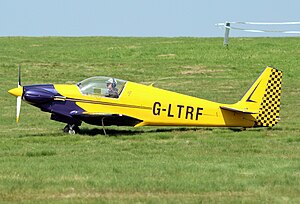German motor glider, 1970
| RF7
|

|
| The RF7 prototype as G-LTRF
|
| Role
|
Motorglider Type of aircraft
|
| National origin
|
France
|
| Manufacturer
|
Fournier
|
| Designer
|
René Fournier
|
| First flight
|
5 March 1970[1]
|
| Number built
|
Two
|
| Developed from
|
Fournier RF 4
|
The Fournier RF7 was a single-seat motorglider designed and built in prototype form by René Fournier in France in 1970 and intended for series production by Sportavia-Pützer in Germany.
Design and development
The RF7 was a conventional motorglider design derived from Fournier's RF 4D,[1] a low-wing cantilever monoplane with an engine mounted in tractor configuration in the nose.[2] The sailplane-style undercarriage consisted of a retractable mainwheel, a fixed tailwheel, and small outriggers under each wing.[1] Compared to the RF 4. the wings were shorter and the tailplane surfaces larger.[1][2] The ailerons were also larger,[3] and the RF7 was fully stressed for aerobatics.[3][4]
Construction of the prototype (registered F-WPXV[3]) began in July 1969,[1] and the aircraft first flew on 5 March 1970.[1] It was displayed at the Hanover Air Show the following month, where the journal Flight International praised it for the quality of its finish "[i]n spite of its prototype status."[3] By 1971, Sportavia-Pützer abandoned its plans of series production of the type and hoped to market the RF7 in kit form instead.[4] By 1978, all development had been abandoned and the prototype was offered for sale.[5]
Specifications
Data from Taylor 1972, p.96
General characteristics
- Crew: one pilot
- Length: 6.05 m (19 ft 11 in)
- Wingspan: 9.40 m (30 ft 11 in)
- Wing area: 10.0 m2 (108 sq ft)
- Empty weight: 300 kg (660 lb)
- Gross weight: 445 kg (981 lb)
- Powerplant: 1 × Sportavia-Limbach SL 1700 D , 51 kW (68 hp)
Performance
- Cruise speed: 220 km/h (137 mph, 119 kn)
- Range: 650 km (403 mi, 350 nmi)
- Service ceiling: 7,000 m (23,000 ft)
